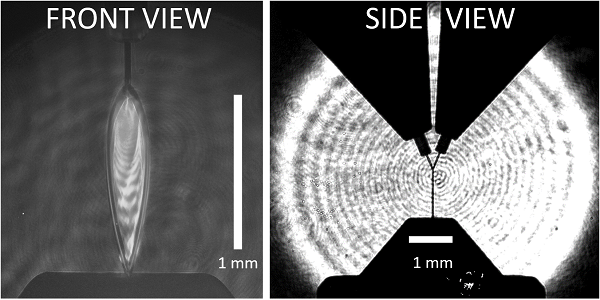Liquid Leaf Targets
Our current workhorse is a free-flowing liquid leaf target formed by the collision of two
cylindrical water jets. By tuning the target parameters, such as the diameter of the water jets or
the flow rate, the overall size and thickness of the liquid leaf target can be altered. The thin-film
interference pattern in the front view image provides a relative thickness map of the target, with
thicknesses down to the sub-micron level at the bottom of the leaf. Compared to a foil target
positioning system, the liquid target offers the possibility of high-repetition-rate experiments, as
the target regenerates itself within a few tens of milliseconds after the laser shot. The ions are
accelerated in the so-called TNSA (Target Normal Sheath Acceleration) process, in which a hot
electron layer is formed on the rear side of the target. The rear surface ions are then
accelerated in the strong space charge field generated by this electron cloud.

Stable high-energy proton acceleration with water-leaf targets driven by intense laser pulses
L. He, M. Bachhammer, F. Balling, S. Biswas, L. Doyle, S. Gerlach, I. Hofrichter, M. Kharbedia, J. Liese, M. Marco, T. Pohle, A. Praßelsperger, A.-K. Schmidt, F. Schweiger, M. Kling, S. Karsch, and J. Schreiber
Phys. Rev. Res. 7, 023190 (2025)

